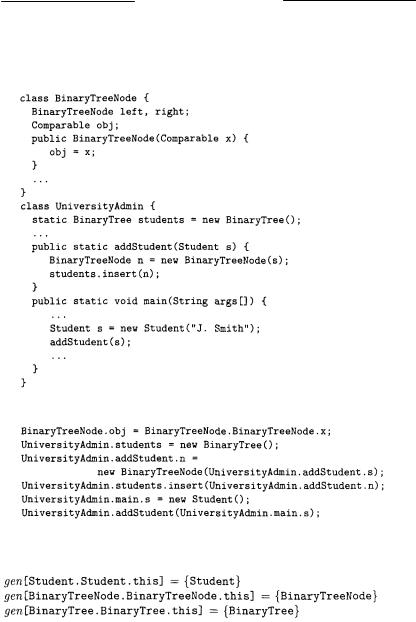
- •Contents
- •Introduction
- •1.1 Reverse Engineering
- •1.2 The eLib Program
- •1.3 Class Diagram
- •1.4 Object Diagram
- •1.5 Interaction Diagrams
- •1.6 State Diagrams
- •1.7 Organization of the Book
- •The Object Flow Graph
- •2.1 Abstract Language
- •2.1.1 Declarations
- •2.1.2 Statements
- •2.2 Object Flow Graph
- •2.3 Containers
- •2.4 Flow Propagation Algorithm
- •2.5 Object sensitivity
- •2.6 The eLib Program
- •2.7 Related Work
- •Class Diagram
- •3.1 Class Diagram Recovery
- •3.2 Declared vs. actual types
- •3.2.2 Visualization
- •3.3 Containers
- •3.4 The eLib Program
- •3.5 Related Work
- •3.5.1 Object identification in procedural code
- •Object Diagram
- •4.1 The Object Diagram
- •4.2 Object Diagram Recovery
- •4.3 Object Sensitivity
- •4.4 Dynamic Analysis
- •4.4.1 Discussion
- •4.5 The eLib Program
- •4.5.1 OFG Construction
- •4.5.2 Object Diagram Recovery
- •4.5.3 Discussion
- •4.5.4 Dynamic analysis
- •4.6 Related Work
- •Interaction Diagrams
- •5.1 Interaction Diagrams
- •5.2 Interaction Diagram Recovery
- •5.2.1 Incomplete Systems
- •5.2.2 Focusing
- •5.3 Dynamic Analysis
- •5.3.1 Discussion
- •5.4 The eLib Program
- •5.5 Related Work
- •State Diagrams
- •6.1 State Diagrams
- •6.2 Abstract Interpretation
- •6.3 State Diagram Recovery
- •6.4 The eLib Program
- •6.5 Related Work
- •Package Diagram
- •7.1 Package Diagram Recovery
- •7.2 Clustering
- •7.2.1 Feature Vectors
- •7.2.2 Modularity Optimization
- •7.3 Concept Analysis
- •7.4 The eLib Program
- •7.5 Related Work
- •Conclusions
- •8.1 Tool Architecture
- •8.1.1 Language Model
- •8.2 The eLib Program
- •8.2.1 Change Location
- •8.2.2 Impact of the Change
- •8.3 Perspectives
- •8.4 Related Work
- •8.4.1 Code Analysis at CERN
- •Index

3.2 Declared vs. actual types |
47 |
sections we will see that this simple method may potentially give rise to inaccuracies in the presence of inheritance, interfaces or containers. Improved class diagrams can be obtained by refining the declared type into more precise information by means of flow propagation in the OFG.
eLib example
In the eLib example (see Appendix A), class Loan has two association relationships with classes User and Document, which can be easily reverse engineered from its code given the presence of two attributes, user and document (lines 134, 135), of the two target classes. Conceptually, they could be regarded as aggregations, rather than associations, in that a loan has a user and a borrowed document as its integral constituents. However, from the analysis of the source code there is no way to distinguish this case from the plain association. In the following, no distinction is made between aggregation and association, and the latter will be used as possibly inclusive of the former.
The class Library performs method invocations on objects of class User and Document through parameters (resp. at line 10 inside addUser and at line 26 inside addDocument) or local variables (resp. at line 17 inside removeUser and at line 33 inside removeDocument). Thus, there is a dependency between Library and User, and between Library and Document.
3.2 Declared vs. actual types
The declared type of attributes, local variables and method parameters is used to determine the target class of associations and dependencies. It is quite typical that the declared type is the root of a sub-tree in the inheritance hierarchy or it is an interface. For example, attributes user and document of class Loan in the eLib program are respectively declared to be of type User, which has InternalUser as a subclass, and Document, which has Book, Journal, and TechnicalReport as subclasses. A hypothetical binary search tree program may contain a class BinaryTreeNode with an attribute obj to store the information to be associated with each tree node. Its declared type could be Comparable, i.e., the interface implemented by objects that can be totally ordered by means of the method compareTo.
When the declared type is the root of an inheritance sub-tree, an association or dependency is inferred from the given class to the root of the sub-tree. In the eLib example, two of the inferred relationships connect Loan to User
48 3 Class Diagram
and Document. If the application program uses only a portion of the inheritance sub-tree, the target of the association/dependency is inaccurate. A more precise target class would consist of the classes of the actually allocated objects. For example, if in a specific instance of the library application only documents of type Book are handled, an association should connect Loan to
Book instead of Document.
The problem is exacerbated with interfaces. Let us consider the binary search tree example sketched above. The presence of an attribute obj of type Comparable would generate an association from BinaryTreeNode to Compa- rable. Since the interface Comparable is not user-defined, such an association is typically not included in the class diagram of the system, since only relationships among user-defined classes are of interest. Let us assume that the application program using the binary search tree defines a class Student which implements the interface Comparable. Objects of type Student are allocated in the program and are assigned to the field obj of BinaryTreeNode objects. In the class diagram for this application, one would expect to see an association from BinaryTreeNode to Student. If the basic reverse engineering method described in Section 3.1 is applied, no such association is actually recovered from the code. Thus, usage of an interface as the type of a class field results in an inaccurate recovery of the class diagram.
In general, there might be a mismatch between the type declared for a program location and the actual types of the objects that are possibly assigned to such a location. In fact, the declared type might be a superclass of, or an interface implemented by, the actual object types. In these cases, a precise recovery of the class diagram can be achieved only by determining the type of the actually allocated objects that are possibly referenced by the program locations under analysis. The flow propagation algorithm presented in Chapter 2 can be used for this purpose.
3.2.1 Flow propagation
Specialization of the generic flow propagation algorithm to refine the declared type of variables requires the specification of the sets gen and kill of each OFG node. Fixpoint of the flow information on the OFG is achieved by the generic procedure given in Chapter 2. Fig. 3.2 shows how the gen set is determined for the OFG nodes. Only nodes of type cs.this have non empty gen set. All other OFG nodes have an empty gen set. All kill sets are empty in this analysis specialization.
Given an object allocation such as statement (5) of Fig. 3.2, the flow information that has to be propagated in the OFG is the exact type of the allocated object. This is the reason why the class name  is inserted into the gen set. The OFG location where the propagation of this flow information starts is the this pointer of the constructor. In fact, that is the very first location holding a reference to the newly allocated object. Thanks to the OFG edges, constructed according to the algorithm described in Chapter 2, this
is inserted into the gen set. The OFG location where the propagation of this flow information starts is the this pointer of the constructor. In fact, that is the very first location holding a reference to the newly allocated object. Thanks to the OFG edges, constructed according to the algorithm described in Chapter 2, this

3.2 Declared vs. actual types |
49 |
Fig. 3.2. Flow propagation specialization to determine the type of actually allocated objects referenced by program locations.
information is propagated to the right hand side  of the allocation statement (5), and from this location it can reach other program locations, according to the object flows. In the end, the class names that reach class attributes indicate the improved targets of association relationships. Similarly, the class names associated with local variables or method parameters allow the refinement of dependency relationships.
of the allocation statement (5), and from this location it can reach other program locations, according to the object flows. In the end, the class names that reach class attributes indicate the improved targets of association relationships. Similarly, the class names associated with local variables or method parameters allow the refinement of dependency relationships.
3.2.2 Visualization
Since flow propagation in the OFG according to the specialization in Fig. 3.2 results in a set of referenced object types for each program location, instead of a single type, a postprocessing that simplifies the output might be appropriate. Each time the types inferred for a location  and available from
and available from  after the fixpont, are coincident with all descendants of a user-defined class A, a single relationship can be produced toward class A, which is assumed to imply a relationship with all subclasses. In this way, the class diagram is not cluttered by relationships toward all subclasses. However, the disadvantage of this graphical representation is that it makes it impossible to distinguish between a relationship with class A only and a relationship with A and all its subclasses.
after the fixpont, are coincident with all descendants of a user-defined class A, a single relationship can be produced toward class A, which is assumed to imply a relationship with all subclasses. In this way, the class diagram is not cluttered by relationships toward all subclasses. However, the disadvantage of this graphical representation is that it makes it impossible to distinguish between a relationship with class A only and a relationship with A and all its subclasses.
In the eLib example, if the result of flow propagation is: out [Loan. user] = {User, InternalUser}, it is possible to draw just one association in the class diagram, between Loan and User. However, this makes the diagram indistinguishable from one produced for a program where no InternalUser is ever allocated. Such an inaccuracy becomes acceptable when the diagram is large and drawing relationships toward all subclasses makes it not understandable and usable. Otherwise, the diagram with more precise relationships should be preferred.
As a general rule, when several relationships are directed from a class to a set of classes, an option to reduce the visual cluttering is replacing them with a single relationship toward the Least Common Ancestor (LCA) of the target classes. The diagram becomes less precise but easier to read.

50 3 Class Diagram
binary search tree example
The importance of applying the flow propagation algorithm to determine the targets of associations and dependencies becomes even more evident when interfaces are used in the program. Let us consider the binary tree example once more. The code fragments relevant to our analysis are the following:
The abstract syntax of the statements above follows:
The related OFG is shown in Fig. 3.3. The only non empty gen sets of its nodes are:
